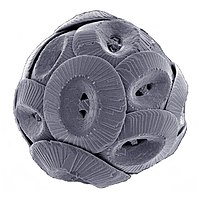
Photo from wikipedia
Collagen, as the main component of connective tissue, is frequently used in various tissue engineering applications. In this study, porous sponge-like collagen scaffolds were prepared by freeze-drying and were then… Click to show full abstract
Collagen, as the main component of connective tissue, is frequently used in various tissue engineering applications. In this study, porous sponge-like collagen scaffolds were prepared by freeze-drying and were then mineralized in a simulated body fluid. The mechanical stability was similar in both types of scaffolds, but the mineralized scaffolds (MCS) contained significantly more calcium, magnesium and phosphorus than the unmineralized scaffolds (UCS). Although the MCS contained a lower percentage (~32.5%) of pores suitable for cell ingrowth (113–357 μm in diameter) than the UCS (~70%), the number of human-osteoblast-like MG-63 cells on days 1, 3 and 7 after seeding was higher on MCS than on UCS, and the cells penetrated deeper into the MCS. The cell growth in extracts prepared by eluting the scaffolds for 7 days in a cell culture medium was also markedly higher in the MCS extracts, as indicated by real-time monitoring in the sensory xCELLigence system for 7 days. From this point of view, MCS are more promising for bone tissue engineering than UCS. However, MCS evoked a more pronounced inflammatory response than UCS, as indicated by the production of tumor necrosis factor-alpha (TNF-α) in macrophage-like RAW 264.7 cells in cultures on these scaffolds.
Journal Title: Polymers
Year Published: 2022
Link to full text (if available)
Share on Social Media: Sign Up to like & get
recommendations!